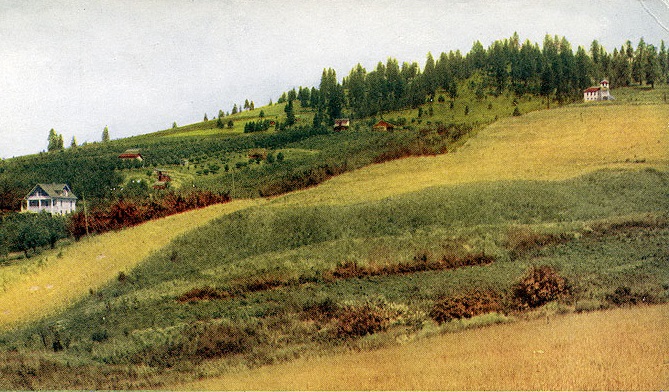
An old postcard circa 1905 showing fruit growing and farming in Central Washington.
We’ve been working with stakeholders to address lead arsenate contamination on former orchard lands across Central Washington. Our year-long effort resulted in recommendations from a broad-based group that included planners, realtors, homebuilders, bankers, developers, health experts, and elected officials. This group helped us create approaches to address contamination and conduct outreach to Central Washington communities. Today, we’re sharing information about one of those approaches — Model Remedies for Cleanup of Former Orchard Properties. These were designed to be efficient, effective, and affordable.
Background
A pesticide called lead arsenate was widely used throughout Central Washington to control codling moth infestations on fruit trees in the early half of the 20th century (between 1900 and 1950). This resulted in widespread lead and arsenic contamination on historic orchard lands — mostly in Yakima, Chelan, Douglas, Okanogan, and parts of Benton counties. Nearly 115,000 acres of land in Central Washington are considered historic orchard lands and are potentially contaminated by lead and arsenic.
Why do we clean up lead and arsenic?
Arsenic and lead are toxic metals. Exposure can increase the risk of certain health problems. Although these metals are not easily absorbed through the skin, living in close proximity to soils contaminated with lead and arsenic will likely result in ingestion of soil and inhalation of dust. We're concerned about small children and people who are regularly exposed to soil, such as construction workers, landscapers, and gardeners. Researchers have linked long-term exposure to arsenic to a variety of health problems.
What is a model remedy?
The state's environmental cleanup law, the Model Toxics Control Act, allows model remedies to be used for routine cleanups at lower risk sites. A model remedy is a cleanup method that has been pre-approved by Ecology. Using a model remedy eliminates the uncertainty of whether your selected remedy will be successful and meet state cleanup requirements.
In this case, the legacy pesticide model remedies contain four cleanup options, and can be used for former orchard properties impacted by lead and arsenic. The four cleanup options are:
1. Excavate and remove
Excavation and removal is the most straightforward option. Contaminated soils are excavated and disposed of properly, usually at a landfill. All contaminated soil must be removed from the property, but no additional actions are required. This is the most permanent option, but generally the most expensive due to the large quantity of soil that must be removed.
2. Hard or soft cap
These two remedies involve placing a barrier over contaminated soil to prevent exposure. This barrier can be something hard, like asphalt, or it can be soil or other landscaping materials. The cap does need to be maintained over time and any future property owner must be notified about the cap. This option is generally the simplest and most cost effective.
3. Consolidate and cap
This remedy involves excavating contaminated soil from portions of a property and consolidating them on the same property below a protective cap. Contaminated soils can be consolidated under permanent surfaces such as asphalt or buildings, or they may be placed in excavated holes or above-ground mounds. Contaminated soils that are not consolidated under permanent surfaces must be capped with an engineered clean soil cap. This remedy is an excellent option for larger residential developments with room to create a consolidation area, for example, at an apartment building with a parking lot where contaminated soil from the entire site can be placed under the parking area.
4. Mixing
For this remedy, contaminated soil is mixed with deeper, clean soil or imported soil. This remedy option is not suitable for soils with high-levels of contamination. The remedy can easily fail if areas of elevated concentrations are missed, so proper sampling upfront is important. Mixing requires availability of enough clean soil, either on-site or imported, to successfully mix contaminated soil to concentrations below state cleanup levels. Any soil used must be sampled to ensure that it's not contaminated.
Notification
Any remedy that contains contaminated soil on the property requires a process to notify future property owners. This can be accomplished in several ways. An appropriate notification method must be agreed upon with Ecology before residential occupancy of a property.
What does this mean for you?
If you own or are buying a house
Check our online former orchard maps to determine if the property is located on a historic orchard. If you find it on the map, email us to find out about free soil sampling.
If you are building a housing development
Sampling is required for new residential housing that is being built on historical orchard land. If sampling shows that lead is present at concentrations above 250 parts per million (ppm) or that arsenic is present at concentrations above 20 ppm, cleanup is required before a new home can be occupied.
Consider working with a consultant. Ecology has a guide for finding and hiring consultants, Focus on: Hiring an Environmental Consultant. You can also ask other colleagues in your industry, environmental professional organizations, or banks for recommendations. Once you get recommendations, follow up with your own research.
Environmental consultants are also listed in the Yellow Pages or can be found online. Ask each firm to prepare a proposal for the sampling work. The proposal should include a detailed approach and cost estimate by specific task. It may be difficult to provide specific estimates for future work because they will depend on the sampling results.
Next post in series
Building homes on former orchard lands: What developers and builders need to know
Previous posts in series
Legacies of lead & arsenic (part 2)
Legacies of lead & arsenic (part 3)
Learn what’s coming up for the Legacy Pesticides Working Group
Keeping the Legacy Pesticide Working Group moving forward
Legacy Pesticides Working Group update

